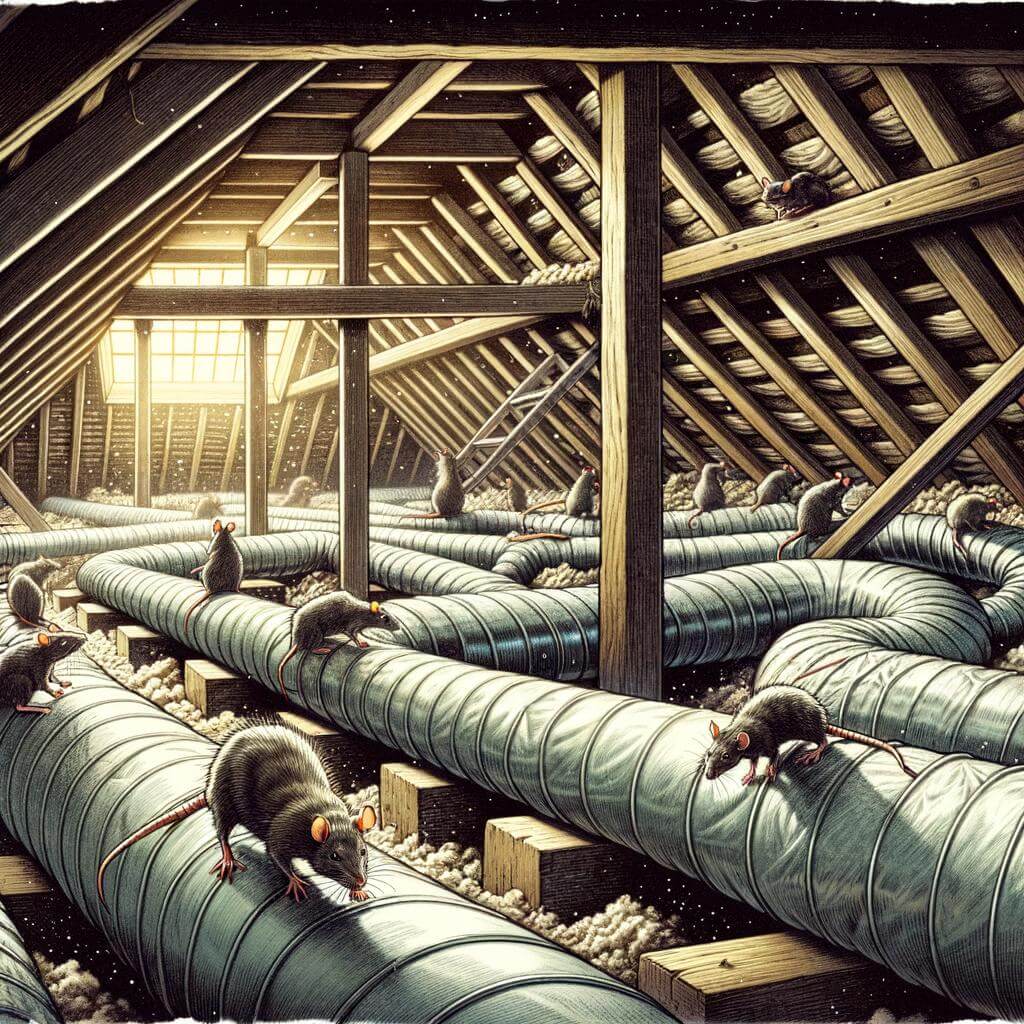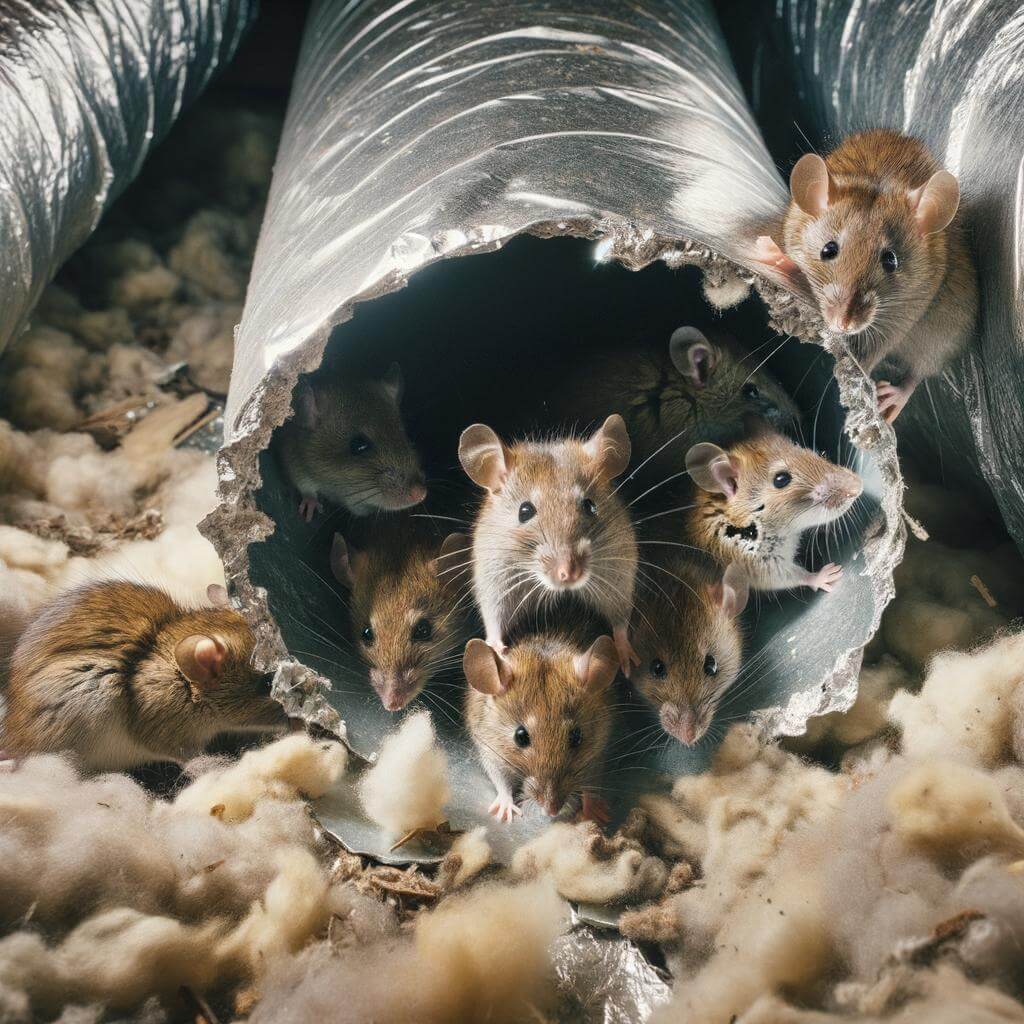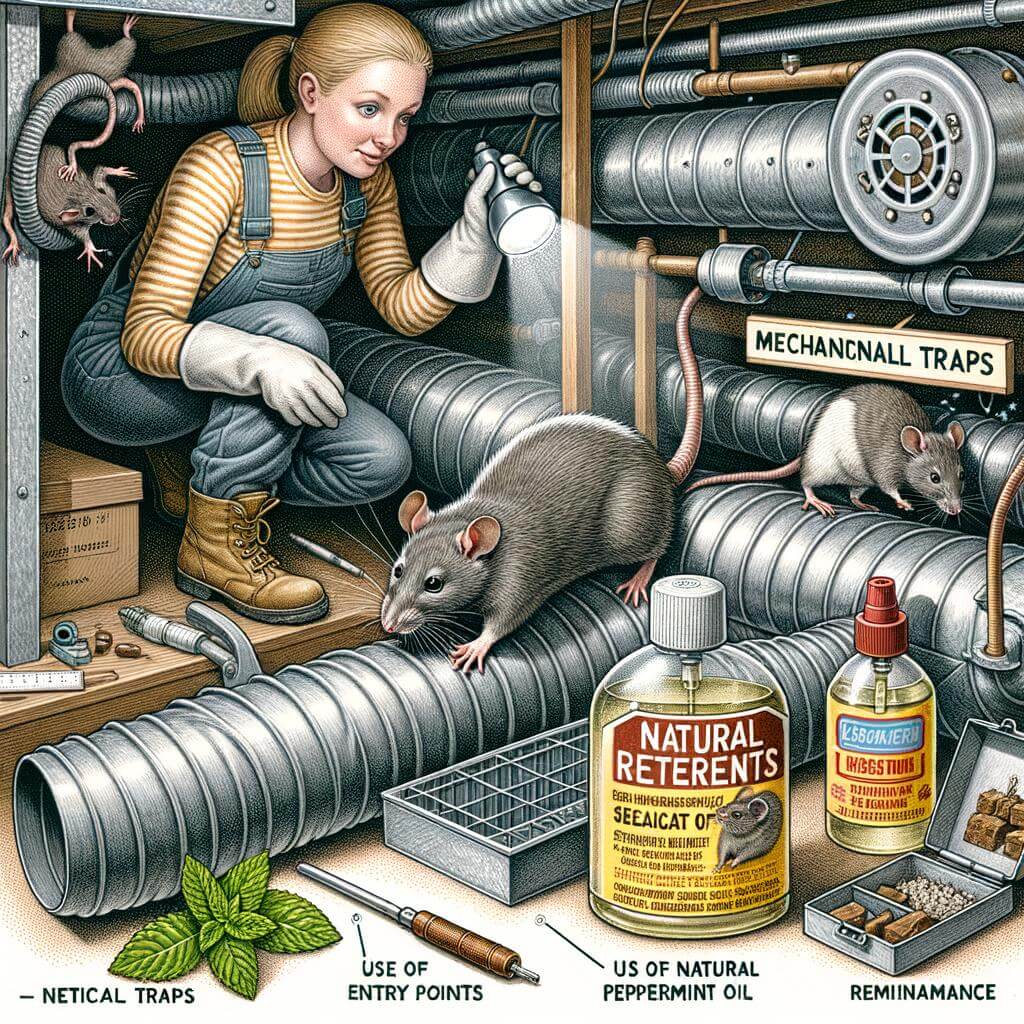Welcome to this educational and insightful post titled, “Understanding Why Rats Nibble Your Attic Ductwork: An Expert’s View”. Here, we shall shed light on the unusual yet common issue of rats gnawing at your attic ductwork, a problem many homeowners face. This post is intended to provide you with a comprehensive understanding of why this happens, backed up by expert opinions and facts. We’ll also provide useful pointers to help you deal with this problem effectively. By the end of this post, you will feel more knowledgeable and empowered to protect your home against these tiny invaders. Ultimately, it aims to save you from potential structural damages and unexpected repair expenses. Get ready to dive into an informative read that could potentially save your attic ductwork from becoming a rat’s gnawing ground!
Understanding Rat Behaviour: The Science Behind Their Chewing Habit
Experience shows that many homeowners are troubled by the incessant gnawing activities of rats on their attic ductwork. This habit of rats is not just some expression of sport or mischief; it’s a fundamental part of their biology. Understanding the science behind their chewing habit goes a long way in devising strategies to deter them.
Rats, like all rodents, are equipped with a pair of incisors that grow continuously throughout their lives. In the wild, this adaptation allows them to feed on tough plant materials, burrow, and defend themselves. Consuming softer diets in an urban setting fails to provide the requisite friction to wear down the teeth.
- Chewing is a way for rats to keep their teeth in check, prevent overgrowth, and maintain sharpness. Much like us filing our nails, rats gnaw on almost anything in their environment including your attic ductwork.
- Rats also use gnawing to gain access to new areas or to escape perceived danger. If a rat thinks that there is food or a nesting site in your attic ductwork, gnawing becomes a means to explore and claim the space.
Gnawing also has a critical role in nervous system development and muscle strengthening in rats. They engage in gnawing activities not just for tooth maintenance but also as a form of exercise and sensory exploration.
| Fact | Explanation |
| Incisors grow continuously | To enable consumption of tough plant materials and wear them down |
| Gnawing maintains incisor length and sharpness | Helps in burrowing, self-defense, and accessing new areas |
| Gnawing aids nervous system and muscle development | Stimulates sensory exploration and provides exercise |
Armed with these insights, it becomes clearer that dealing with rat behavior requires a combination of methods. These include making your home less attractive to them, deploying mechanical and chemical control measures, and physically proofing potential sites of gnawing activity.

Identifying Signs of Rat Infestation in Your Attic
Many homeowners often wonder why rats decide to feast on their attic ductwork. Contrary to popular belief, it isn’t the material that attracts them. Rats are attracted to the heat that your ductwork gives off and the shelter it provides from the harsh outdoor environment. Your ductwork could have the signs that signal a severe rat infestation. Excessive noise, especially at night, as if something is moving or running, should not be overlooked.
- Rat droppings: One significant infestation sign is the presence of rat excrement. Rats produce a large number of droppings due to their high metabolic rate. If you notice an increase of small, dark pellets, you may have a rat problem.
- Gnaw marks: Another sign of rat infestation is gnaw marks. Rats love to chew, and if you notice odd chewing or scratching sounds, or find cable, wood, and ductwork with signs of gnawing, it could mean rats are nearby.
- Nests: Rats typically create nests using shredded material, such as insulation and cardboard. If you come across any strange nests in your attic, be wary – it could be a sign of an infestation.
To ensure a rat-free attic, you need to be diligent in checking these signs and investing in appropriate preventative measures. However, many people miss these signs due to a lack of a specific, sharp-eyed inspection.
| Infestation Sign | What to Do |
|---|---|
| Rat droppings | Contact a pest control professional or clean the area with a 10% bleach solution |
| Gnaw marks | Seek professional help to repair the damaged area and consider using rat repellent |
| Nests | Remove with gloves, clean the area, and seal any entry holes or gaps |
An attic infested by rats isn’t just damaging but also poses a health risk to your family through the spread of disease. Knowing the signs to watch out for and taking immediate action once these signs are detected is crucial in preventing a full-scale infestation.

Why Your Attic Ductwork is a Prime Target for Rats
Most homeowners might not be aware that their attic ductwork can often come under the radar of rodents, particularly rats. This is due to the fact that the attic provides a warm, safe and secluded habitat, away from the risk of predators. Ductwork, on the other hand, offers rats the perfect nibbling material. This comes from their instinctive nature to always keep their teeth sharp and at the right size for survival.
Looking at some reasons why your attic ductwork is appealing to rats reveals the following points:
- Texture: The texture of ductwork’s material is acceptable for rats to gnaw on. The metal sheathing is also thick enough to keep their teeth from growing too long and causing discomfort.
- Taste: Believe it or not, rats don’t mind the taste of the insulation in your attic ductwork!
- Warmth: The warm air passing through the ductwork provides a source of heat for rats, particularly in the colder months.
- Security: Nesting in attic ductwork can save rats from the frequent disturbance of humans.
| The Severity Of Ductwork Damage Caused By Rats | |
|---|---|
| Low: | at the outset, you may notice minor noises and reduced heating/cooling efficiency |
| Moderate: | significant holes in your ductwork can lead to increased energy bills and compromised air quality |
| Severe: | chewed through ductwork can cause major temperature imbalances and damage to the HVAC system |
In brief, the refuge and edible delight offered by your attic ductwork can draw in rats, and without quick intervention, this could escalate to substantial damage. It is therefore essential to keep a routine look-out for signs of rat infiltration and enlist the help of pest professionals if you suspect infestation.

Impact of Rat Nibbling on Attic Ductwork
Rats have a natural inclination towards gnawing incessantly to maintain the sharpness and length of their teeth. This destructive tendency can turn a perfectly good attic into a nightmare, especially when the unfortunate target is your ductwork. House-owners often underestimate the havoc that a small creature can wreak on their HVAC system. Rat nibbling can lead to significant issues like air leakage, reductions in energy efficiency and even mould growth owing to the damp areas that arise due to condensation where the insulation has been removed.
In the long run, repeated rat incursions and persistent gnawing can seriously compromise the structural integrity of your ductwork. Let’s take a closer look at the damages these seemingly harmless creatures can cause:
- Air Leakage: Openings created by the rats can cause the heated or cooled air to escape.
- Lowered Efficiency: The HVAC system needs to work harder to maintain the desired temperature leading to higher energy consumption.
- Mould Growth: Moist areas due to insulation removal can lead to mould which affects the air quality.
It’s important to get a professional inspection as soon as you suspect rat activity. Remember, the longer you ignore the problem, the more extensive and costly the repairs will be. A thorough inspection and repair by professionals can ensure that these issues are nipped in the bud. Use a rat-proofing service to ensure that once evicted, these pests don’t return.
| Damage | Impact |
|---|---|
| Air leakage | Increased energy costs |
| Lowered efficiency | Increased strain on HVAC, potential system failure |
| Mould growth | Poor indoor air quality leading to health hazards |
Attics are optimal nesting areas for rats. Timely intervention can save you from a massive amount of trouble and restoration costs. Emphasizing preventive measures like attic proofing, sealing potential entry points, and regular inspection can keep your attic rat-free and your ductwork intact.

Expert Strategies to Safeguard Your Ductwork Against Rats
The first significant strategy emphasizes routine inspection and maintenance. Regular assessment of your ductwork can quickly identify potential breaches that might welcome unwanted rodent visitors. Monitor spaces like your attic and basement areas, paying special attention to signs such as odd noises, droppings, and gnaw marks that suggest the presence of rats. Regular bodily inspection can be complemented by a professional pest control company’s services that are capable of identifying and sealing potential entry points, such as smaller cracks or gaps in the ductwork.
| Professional Services | Brief Description |
|---|---|
| Regular Inspections | Physical examination of your ductwork by a professional team |
| Rodent-Proofing Concept | Identifying and sealing potential entry points to prevent rat infiltration |
| Precautionary Sealing | Application of metal mesh or repaired sealant through potential gaps |
The second important strategy is to adjust the environment around your home aiming to create a less appealing space for rats. Rodents favor cluttered, quieter spaces, so ensuring that your attic area is tidy and clear of debris can be a proactive measure in deterring rat infestations. Trim overgrown trees and shrubs near your house to limit their pathways to your roof and subsequent ductwork. Moreover, as rats are attracted to food sources, it’s crucial to securely store any food and securely dispose of your waste, adding an extra layer of deterrent for potential invaders.
- Clearing Clutter: Keeping your spaces, especially attic and basement areas, clean can deter rats.
- Trimming Vegetation: Overgrown trees near your house offer a route for rodents. Regular trimming can limit this access.
- Proper Storage and Disposal: Securely store foods and dispose of waste correctly to minimize food sources for rats.
Always remember to consult a professional if you believe there is high risk of rats infiltrating your ductwork. These preventative measures work best when used in combination, offering the most comprehensive defense system against rodent damage.
Proactive Measures and Long-Term Solutions to Deterring Attic Invaders
To proactively prevent rats and other pests from accessing your attic and chewing on your ductwork, it is essential to take several preventative steps and think long-term. For a start, ensuring there is no easy access into your attic is paramount. Check all vents, eave gaps, cable holes, and so forth, sealing off any potential entrances. Meanwhile, keeping your attic and the rest of your house clean and clutter-free can discourage rats, as they are less likely to settle in a space that offers fewer hiding places or nesting materials.
- Trimming overhanging tree branches can prevent rats from jumping onto your roof and finding their way inside.
- Storing food correctly, especially pet food or bird seeds which can attract pests.
- Regularly inspecting your attic for signs of rats or damage can allow you to catch the problem before it escalates.
On a more long-term perspective, consider investing in a professional pest control service. Experts are able to thoroughly inspect your home, identify any potential problems, and offer tailored solutions. It’s also a good idea to replace any standard plastic ductwork with metal ductwork. Rats are deterred by this tougher material, making it a preventative measure that could save you from future trouble.
| Pest Control Solution | Brief Description |
|---|---|
| Professional Inspection and Prevention Service | Experts assess your home, identify potential problems and implement tailored solutions |
| Replace Plastic Ductwork with Metal | Metal is much harder for rats to chew through, reducing the likelihood of future invasions |
Remember, the goal is not just to handle an invasion when it occurs, but to create an environment that is unattractive to rats and make it difficult for them to gain entry in the first place. In the long run, these proactive measures can save you from stress, property damage, and costly repairs.
In Retrospect
In conclusion, it’s evident that having rats nibble away at your attic ductwork can be a significant dilemma, resulting in both financial and health implications. It is essential to understand what triggers such behavior to strategize effectively in eliminating this nuisance. Ductwork’s appeal to rats, from the warm shelter to the teething benefits, is indeed undeniable. However, armed with this specialist knowledge, you can take steps towards rat-proofing your home, setting up deterrents, or safely removing an existing rat colony. Remember, your ductwork doesn’t have to be a rat’s paradise. This marks the end of a comprehensive look into why rats target your attic ductwork, leaving you more knowledgeable and prepared to address such issues. We trust that you’ve found this article both educational and helpful. Here’s to a rat-free ductwork system and long-lasting peace in your attic!




